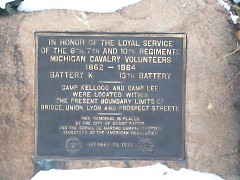As you walk by the many shops and buildings in Heritage Hill that we have grown fond off, buildings like Martha’s Vineyard or Central High School, do you ever wonder what existed here before? I have a passion for history and one of my favorite subjects is the American Civil War. When I was a child, my uncle told me there were Civil War encampments located around the city, and one of them was located in what is the present square boundary of Michigan, Prospect, Lyon, and Union streets.
I have thought about this for a long time and I finally felt that I should look further into the history of the camp. This brought me to the Grand Rapids Public Library's local history department to look into the city’s Civil War archives.
In the local Civil War files, there are various written histories based off the diary of Rebecca Richmond, daughter of William A Richmond, a very prominent citizen of Grand Rapids. She was 21 when the war broke out in 1861. Her detailed descriptions paint a good picture of the city during the war.
Let us consider the City of Grand Rapids at the beginning of the war in 1861. The city had been incorporated in 1853 with a population of 3,500. By 1861 it had a population of 8,000 residents. All the activities of the town centered around what we now know as Campau Square. It consisted of some fine stores, two justice courts, half a dozen dives, places of bad character, some poker rooms and several basement bars.
There were three encampments in the city. One was at the cities old fair grounds located two miles south of the city. This is the old South High School building that presently Job Corp on Hall and Jefferson.
The second camp was called Camp Kellogg; it was named after Congressmen Francis W. Kellogg who organized the Sixth Calvary Regiment that mustered on October 13, 1862 in Grand Rapids. They were the first occupants of the camp in 1862. The camp was located between the borders of present day Michigan, Prospect, Union and Lyon streets.
The third camp, within the same boundaries, called Camp Lee was located next to Camp Kellogg. A book written by Richard Machesky, Activity on the Brink: A Short History of Grand Rapids Michigan during the Civil War, describes Camp Lee. Camp Lee was the largest of all the camps. Early in 1864, Camp Lee became the central point for handling the influx of soldiers into Grand Rapids. The camp had a population that ranged from 3,000 to 5,000 at various times. The large population of soldiers brought problems to the city. There were several cases of desertion, disorderly conduct, and drunkenness. To manage this problem, Camp Lee also served as a jail for Union soldiers who committed crimes.
While researching Camp Lee, I happened upon a piece of history that was extraordinary. Archive number 106, the Camp Lee Guard Log, has been in the possession of Grand Rapids Public Library since 1920. It is a guard record for a six-month period from November 1863 to April 1864. It was kept by Captain Sheldon, who was in charge of the camp for some time. When Dr. Sheldon died in 1916, the log book went to Miss Sue Silliman. Miss Silliman, knowing the significance of the book, gave it to the city.
The book is a breathtaking, detailed account of the guards and prisoners. It states the soldiers' names and what led to their imprisonment. On November 23, 1863, J. Baker from Company J was arrested for gambling. The most interesting record is the one for Private Wm. Young who was arrested for leading a large mutiny in the camp in 1864.
The only remnant left to inform people about the camps existence is a plaque placed on October 14, 1912 by the City of Grand Rapids. It is located in front of Central High School near the south east corner of the building.
Next time you’re walking around the neighborhood or grabbing some spirits at Martha’s take a second and think about the camp that use to exist there and the men who inhabited the camp 145 years ago on their way to war. Many of them gave their lives to preserve the union which we enjoy so much today.
The Rapidian, a program of the 501(c)3 nonprofit Community Media Center, relies on the community’s support to help cover the cost of training reporters and publishing content.
We need your help.
If each of our readers and content creators who values this community platform help support its creation and maintenance, The Rapidian can continue to educate and facilitate a conversation around issues for years to come.
Please support The Rapidian and make a contribution today.



